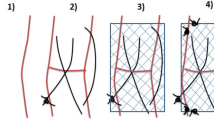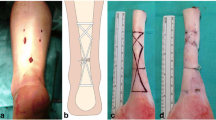Abstract
Background
The Krackow technique has the advantage of high strength, though it is not minimally invasive. The “Locking Block Modified Krackow” (LBMK) peri-tendon fixation technique was designed for minimally invasive surgery. This study aimed to compare the biomechanics of LBMK with Kessler and Percutaneous Achilles Repair System (PARS) techniques using a simulated early rehabilitation program.
Materials and methods
Thirty-fresh bovine Achilles tendon specimens were randomly assigned to the LBMK, Kessler, and PARS groups (n = 10). In LBMK group, the main suture configuration was the LBMK technique, and the transverse suture was used as the secondary suture configuration. The Kessler group employed three suture configurations, two sagittal, one coronal plane. In the PARS group, two transverse and one locking sutures were placed at either end of the tendon. Each repaired specimen underwent two cyclic loading protocols (20–100 N, 20–190 N), 500 cycles, followed by measurement of the gap between the tendon ends. All specimens underwent a load-to-failure test at a 25 mm/s stretching rate.
Results
After the first loading cycle, the average gaps of the LBMK, Kessler and PARS groups were 0.76 ± 0.44 mm, 1.80 ± 0.82 mm, and 2.66 ± 1.04 mm, respectively. The LBMK group had a significantly reduced gap than the other groups (p < 0.01). The LBMK group gaps were all within 2 mm. The Kessler and PARS groups had six, and two specimens within 2 mm, respectively. After the second loading cycle, the average end gaps of the LBMK, Kessler, and PARS groups were 3.68 ± 1.08 mm, 5.70 ± 0.89 mm and 7.59 ± 1.26 mm, respectively. The LBMK group had a significantly reduced average gap than the other groups (p < 0.01). The maximum load-to-failure was highest 732.8 ± 138 N in the LBMK than the other groups (p < 0.01).
Conclusion
The biomechanical strength of the LBMK suture was significantly greater than Kessler and PARS. The reduced gap in the LBMK group suggests superior resistance to gap formation, which may occur during early postoperative rehabilitation.








Similar content being viewed by others
References
Fischer S, Colcuc C, Gramlich Y, Stein T, Abdulazim A, von Welck S, Hoffmann R (2020) Prospective randomized clinical trial of open operative, minimally invasive and conservative treatments of acute Achilles tendon tear. Arch Orthop Trauma Surg. https://doi.org/10.1007/s00402-020-03461-z (Epub ahead of print)
McCoy BW, Haddad SL (2010) The strength of Achilles tendon repair: a comparison of three suture techniques in human cadaver tendons. Foot Ankle Int 31(8):701–705
Krackow KA, Thomas SC, Jones LC (1986) A new stitch for ligament-tendon fixation. J Bone Jt Surg Am 68(5):764–766
Gebauer M, Beil FT, Beckmann J, Sárváry AM, Ueblacker P, Ruecker AH, Holste J, Meenen NM (2007) Mechanical evaluation of different techniques for Achilles tendon repair. Arch Orthop Trauma Surg 127(9):795–799
Watson TW, Jurist KA, Yang KH (1995) The strength of Achilles tendon repair: an in vitro study of the biomechanical behavior in human cadaver tendons. Foot Ankle Int 16(4):191–195
Krackow KA, Thomas SC, Jones LC (1988) Ligament-tendon fixation: analysis of a new stitch and comparison with standard techniques. Orthopedics 11(6):909–917
Hsu AR, Jones CP, Cohen BE, Davis WH, Ellington JK, Anderson RB (2015) Clinical outcomes and complications of percutaneous Achilles repair system versus open technique for acute Achilles tendon ruptures. Foot Ankle Int 36(11):1279–1286
Haji A, Sahai A, Symes A, Vyas JK (2004) Percutaneous versus open tendo Achilles repair. Foot Ankle Int 25(4):215–218
Yang B, Liu Y, Kan S, Zhang D, Xu H, Liu F, Ning G, Feng S (2017) Outcomes and complications of percutaneous versus open repair of acute Achilles tendon rupture: a meta-analysis. Int J Surg 40:178–186
Gatz M, Driessen A, Eschweiler J, Tingart M, Migliorini F (2020) Open versus minimally-invasive surgery for Achilles tendon rupture: a meta-analysis study. Arch Orthop Trauma Surg. https://doi.org/10.1007/s00402-020-03437-z (Epub ahead of print)
Clanton TO, Haytmanek CT, Williams BT, Civitarese DM, Turnbull TL, Massey MB, Wijdicks CA, LaPrade RF (2015) A biomechanical comparison of an open repair and 3 minimally invasive percutaneous Achilles tendon repair techniques during a simulated, progressive rehabilitation protocol. Am J Sports Med 43(8):1957–1964
Assal M, Jung M, Stern R, Rippstein P, Delmi M, Hoffmeyer P (2002) Limited open repair of Achilles tendon ruptures: a technique with a new instrument and findings of a prospective multicenter study. J Bone Jt Surg Am 84(2):161–170
Labib SA, Rolf R, Dacus R, Hutton WC (2009) The "Giftbox" repair of the Achilles tendon: a modification of the Krackow technique. Foot Ankle Int 30(5):410–414
Labib SA, Hoffler CE 2nd, Shah JN, Rolf RH, Tingan A (2016) The gift box open Achilles tendon repair method: a retrospective clinical series. J Foot Ankle Surg 55(1):39–44
Tian J, Rui R, Xu Y, Yang W, Chen X, Zhang X, Xu T (2020) Achilles tendon rupture repair: biomechanical comparison of the locking block modified Krackow technique and the Giftbox technique. Injury 51(2):559–564
Akizuki KH, Gartman EJ, Nisonson B, Ben-Avi S, McHugh MP (2001) The relative stress on the Achilles tendon during ambulation in an ankle immobilizer: implications for rehabilitation after Achilles tendon repair. Br J Sports Med 35(5):329–333
Demetracopoulos CA, Gilbert SL, Young E, Baxter JR, Deland JT (2014) Limited-open Achilles tendon repair using locking sutures versus nonlocking sutures: an in vitro model. Foot Ankle Int 35(6):612–618
Lee SJ, Sileo MJ, Kremenic IJ, Orishimo K, Ben-Avi S, Nicholas SJ, McHugh M (2009) Cyclic loading of 3 Achilles tendon repairs simulating early postoperative forces. Am J Sports Med 37(4):786–790
Van Dyke RO, Chaudhary SA, Gould G, Trimba R, Laughlin RT (2017) Biomechanical Head-to-Head comparison of 2 sutures and the Giftbox versus Bunnell techniques for midsubstance Achilles tendon ruptures. Orthop J Sports Med 30(5):2325967117707477
Ostrander RV 3rd, Saper MG, Juelson TJ (2016) A biomechanical comparison of modified Krackow and locking loop suture patterns for soft-tissue graft fixation. Arthroscopy 32(7):1384–1388
Grieco PW, Frumberg DB, Weinberg M, Pivec R, Naziri Q, Uribe JA (2015) Biomechanical evaluation of varying the number of loops in a repair of a physiological model of Achilles tendon rupture. Foot Ankle Int 36(4):444–449
Maquirriain J (2011) Achilles tendon rupture: avoiding tendon lengthening during surgical repair and rehabilitation. Yale J Biol Med 84(3):289–300
Guzzini M, Lanzetti RM, Proietti L, Mazza D, Fabbri M, Monaco E, Ferri G, Ferretti A (2017) Interlocking horizontal mattress suture versus Kakiuchi technique in repair of Achilles tendon rupture: a biomechanical study. J Orthop Traumatol 18(3):251–257
Lee SJ, Goldsmith S, Nicholas SJ, McHugh M, Kremenic I, Ben-Avi S (2008) Optimizing Achilles tendon repair: effect of epitendinous suture augmentation on the strength of AT repairs. Foot Ankle Int 29(4):427–432
Acknowledgements
The authors would like to thank laboratory technicians Wen Zhang at the Orthopedics Institute, Soochow University for his help and cooperation.
Funding
This study was funded by the Science Foundation of Wuxi Health and Family Planning Commission (MS201743).
Author information
Authors and Affiliations
Contributions
All authors contributed to the study conception and design. Material preparation, data collection and analysis were performed by JT, TX, RR, YX, WY, XC and XZ. The first draft of the manuscript was written by JT and all authors commented on previous versions of the manuscript. All authors read and approved the final manuscript.
Corresponding author
Ethics declarations
Conflict of interest
The authors declare that they have no conflict of interest.
Ethics approval
This study was reviewed and approved by the Ethics Review Board of Soochow University Affiliated Wuxi Ninth People’s Hospital. The Principles of laboratory animal care (NIH publication No. 86-23, revised 1985) were followed as well as any specific national laws where applicable.
Additional information
Publisher's Note
Springer Nature remains neutral with regard to jurisdictional claims in published maps and institutional affiliations.
Rights and permissions
About this article
Cite this article
Tian, J., Rui, Y., Xu, Y. et al. A biomechanical comparison of Achilles tendon suture repair techniques: Locking Block Modified Krackow, Kessler, and Percutaneous Achilles Repair System with the early rehabilitation program in vitro bovine model. Arch Orthop Trauma Surg 140, 1775–1782 (2020). https://doi.org/10.1007/s00402-020-03535-y
Received:
Accepted:
Published:
Issue Date:
DOI: https://doi.org/10.1007/s00402-020-03535-y




